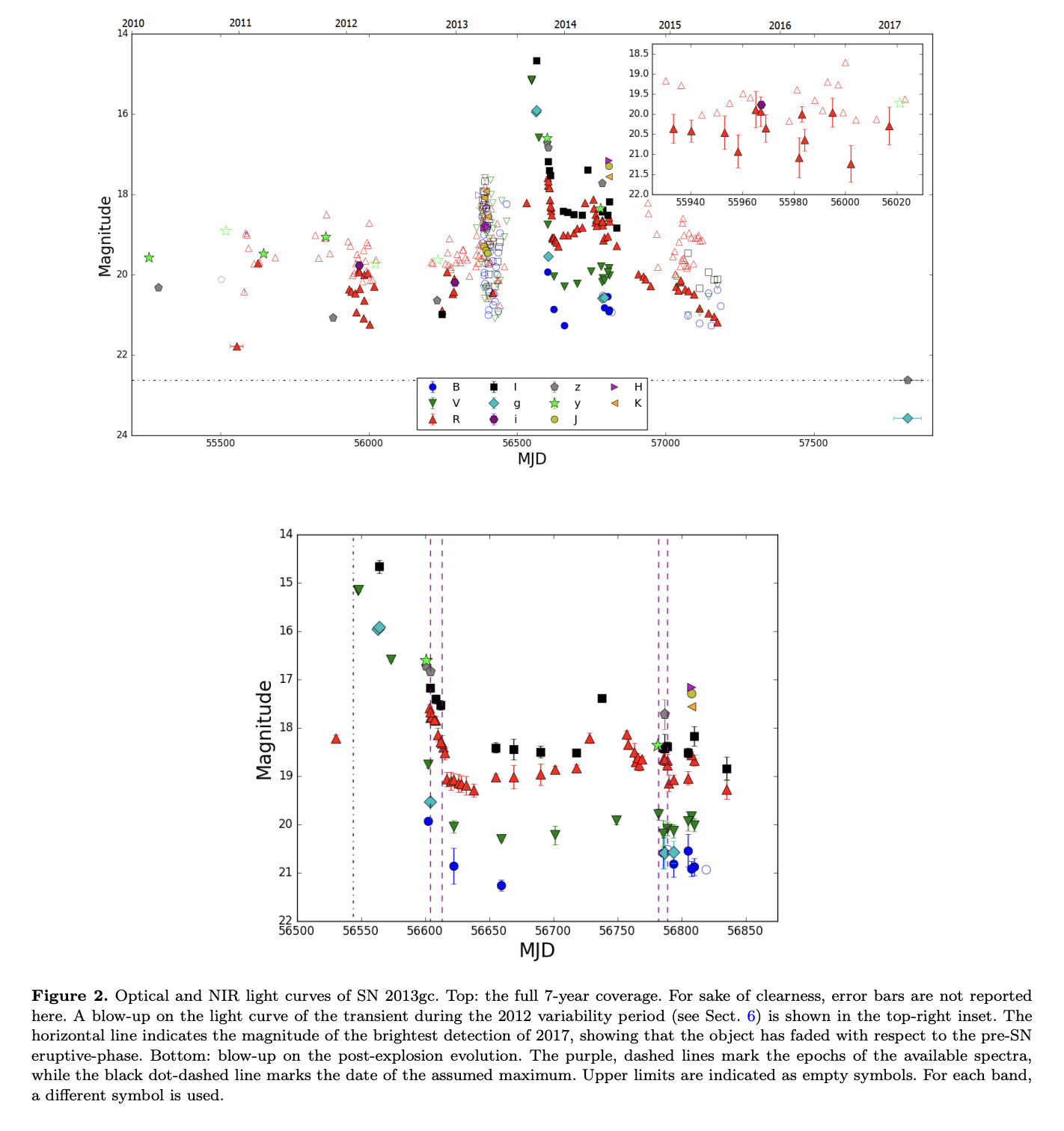Padova-Asiago Supernova Group
Highlights
Signatures of an eruptive phase before the explosion of the peculiar core-collapse SN 2013gc
Reguitti, A. et al. 2019, MNRAS 482, 2750 (link to pdf)
We present photometric and spectroscopic analysis of the peculiar core-collapse SN 2013gc, spanning seven years of observations. The light curve shows an early maximum followed by a fast decline and a phase of almost constant luminosity. At +200 days from maximum, a brightening of 1 mag is observed in all bands, followed by a steep linear luminosity decline after +300 d. In archival images taken between 1.5 and 2.5 years before the explosion, a weak source is visible at the supernova location, with mag≈20. The early supernova spectra show Balmer lines, with a narrow (∼560 km s−1 ) P-Cygni absorption superimposed on a broad (∼3400 km s−1) component, typical of type IIn events. Through a comparison of colour curves, absolute light curves and spectra of SN 2013gc with a sample of supernovae IIn, we conclude that SN 2013gc is a member of the so-called type IId subgroup. The complex profile of the Hα line suggests a composite circumstellar medium geometry, with a combination of lower velocity, spherically symmetric gas and a more rapidly expanding bilobed feature. This circumstellar medium distribution has been likely formed through major massloss events, that we directly observed from 3 years before the explosio. The modest luminosity (MI ∼ −16.5 near maximum) of SN 2013gc at all phases, the very small amount of ejected 56Ni (of the order of 10−3 M ), the major pre-supernova stellar activity and the lack of prominent [O i] lines in late-time spectra support a fall-back core-collapse scenario for the massive progenitor of SN 2013gc. 187
Reguitti, A. et al. 2019, MNRAS 482, 2750 (link to pdf)
We present photometric and spectroscopic analysis of the peculiar core-collapse SN 2013gc, spanning seven years of observations. The light curve shows an early maximum followed by a fast decline and a phase of almost constant luminosity. At +200 days from maximum, a brightening of 1 mag is observed in all bands, followed by a steep linear luminosity decline after +300 d. In archival images taken between 1.5 and 2.5 years before the explosion, a weak source is visible at the supernova location, with mag≈20. The early supernova spectra show Balmer lines, with a narrow (∼560 km s−1 ) P-Cygni absorption superimposed on a broad (∼3400 km s−1) component, typical of type IIn events. Through a comparison of colour curves, absolute light curves and spectra of SN 2013gc with a sample of supernovae IIn, we conclude that SN 2013gc is a member of the so-called type IId subgroup. The complex profile of the Hα line suggests a composite circumstellar medium geometry, with a combination of lower velocity, spherically symmetric gas and a more rapidly expanding bilobed feature. This circumstellar medium distribution has been likely formed through major massloss events, that we directly observed from 3 years before the explosio. The modest luminosity (MI ∼ −16.5 near maximum) of SN 2013gc at all phases, the very small amount of ejected 56Ni (of the order of 10−3 M ), the major pre-supernova stellar activity and the lack of prominent [O i] lines in late-time spectra support a fall-back core-collapse scenario for the massive progenitor of SN 2013gc. 187
